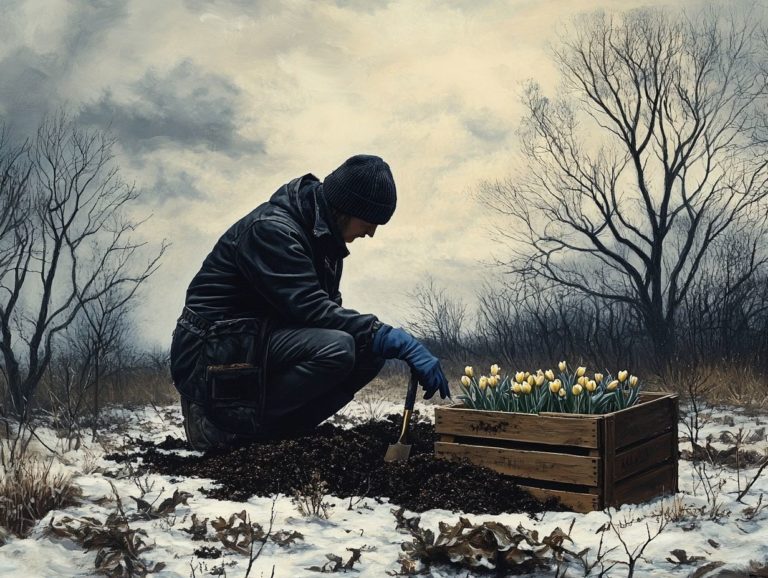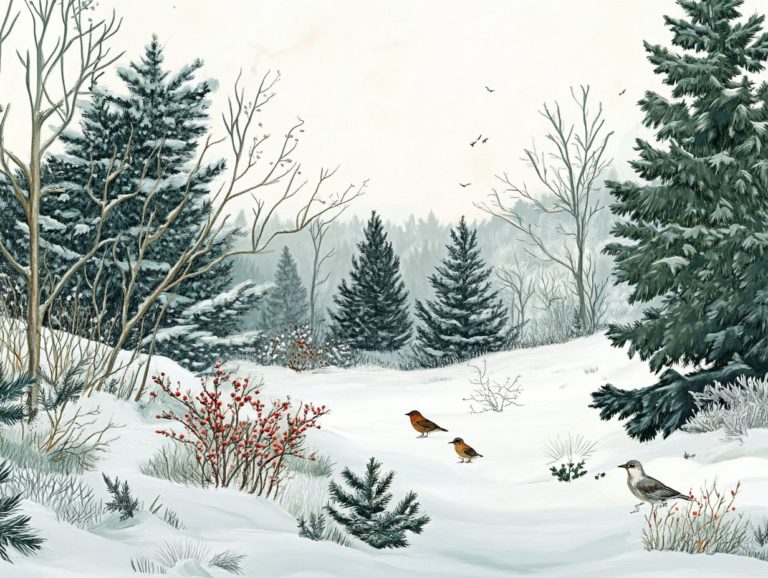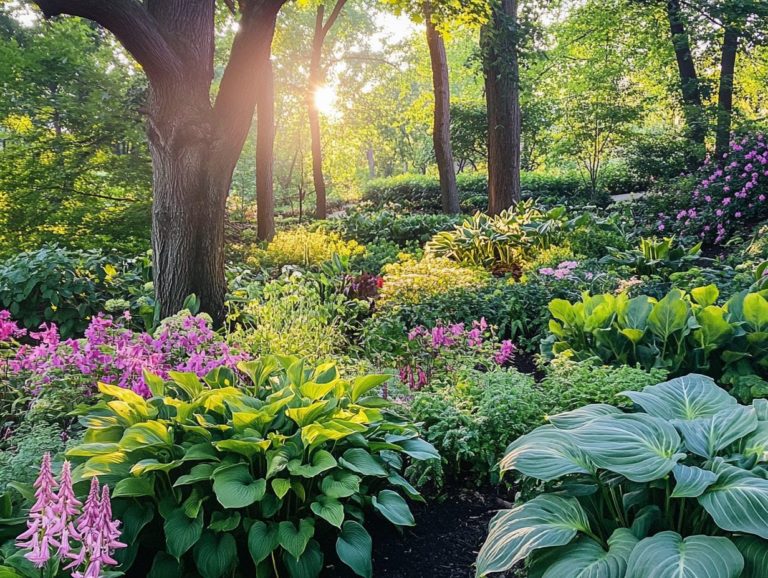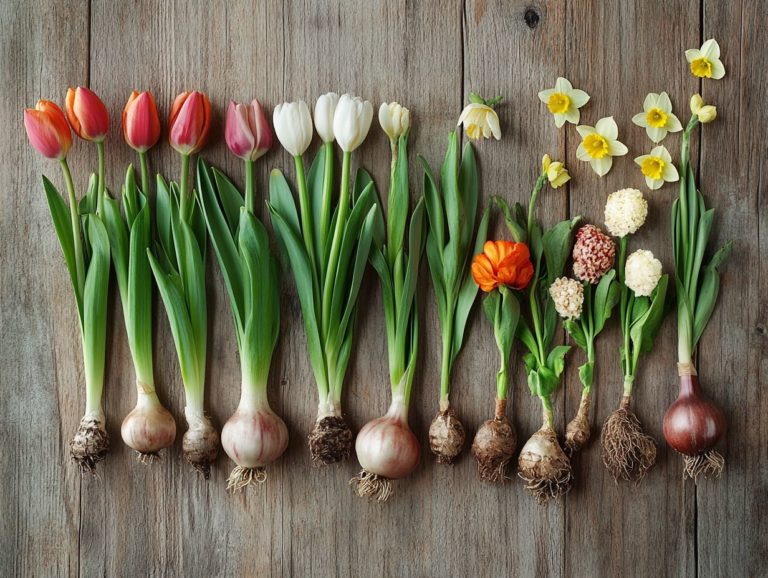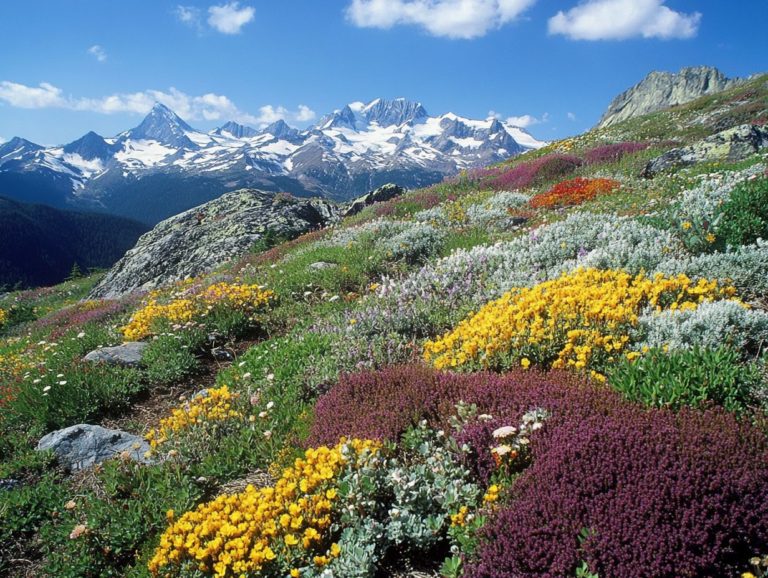Best Annual Flowers for Spring in Cold Climates
Spring unveils a tapestry of color and vitality, even in the briskest of climates. If you re eager to cultivate a vibrant garden amid the chill, you re in for a treat.
This article showcases the finest annual flowers that flourish in cooler temperatures, infusing your outdoor spaces with brilliance. From the joyful daffodils to the sophisticated peonies, you ll discover expert insights on planting, caring for, and reveling in these exquisite blooms.
Prepare to transform your garden into a springtime sanctuary!
Contents
- Key Takeaways:
- 1. Daffodils
- 2. Tulips
- 3. Hyacinths
- 4. Pansies
- 5. Violas
- 6. Snapdragons
- 7. Sweet Alyssum
- 8. Primroses
- 9. Bleeding Hearts
- 10. Peonies
- 11. Lilacs
- 12. Hellebores
- 13. Snowdrops
- 14. Crocuses
- 15. Irises
- What Makes These Flowers Ideal for Cold Climates?
- Frequently Asked Questions
- What are the best annual flowers for spring in cold climates?
- Can I plant annual flowers in cold climates?
- When is the best time to plant annual flowers for spring in cold climates?
- How can I protect annual flowers in cold climates?
- What are some tips for caring for annual flowers in cold climates?
- Are there any annual flowers that can withstand freezing temperatures?
Key Takeaways:
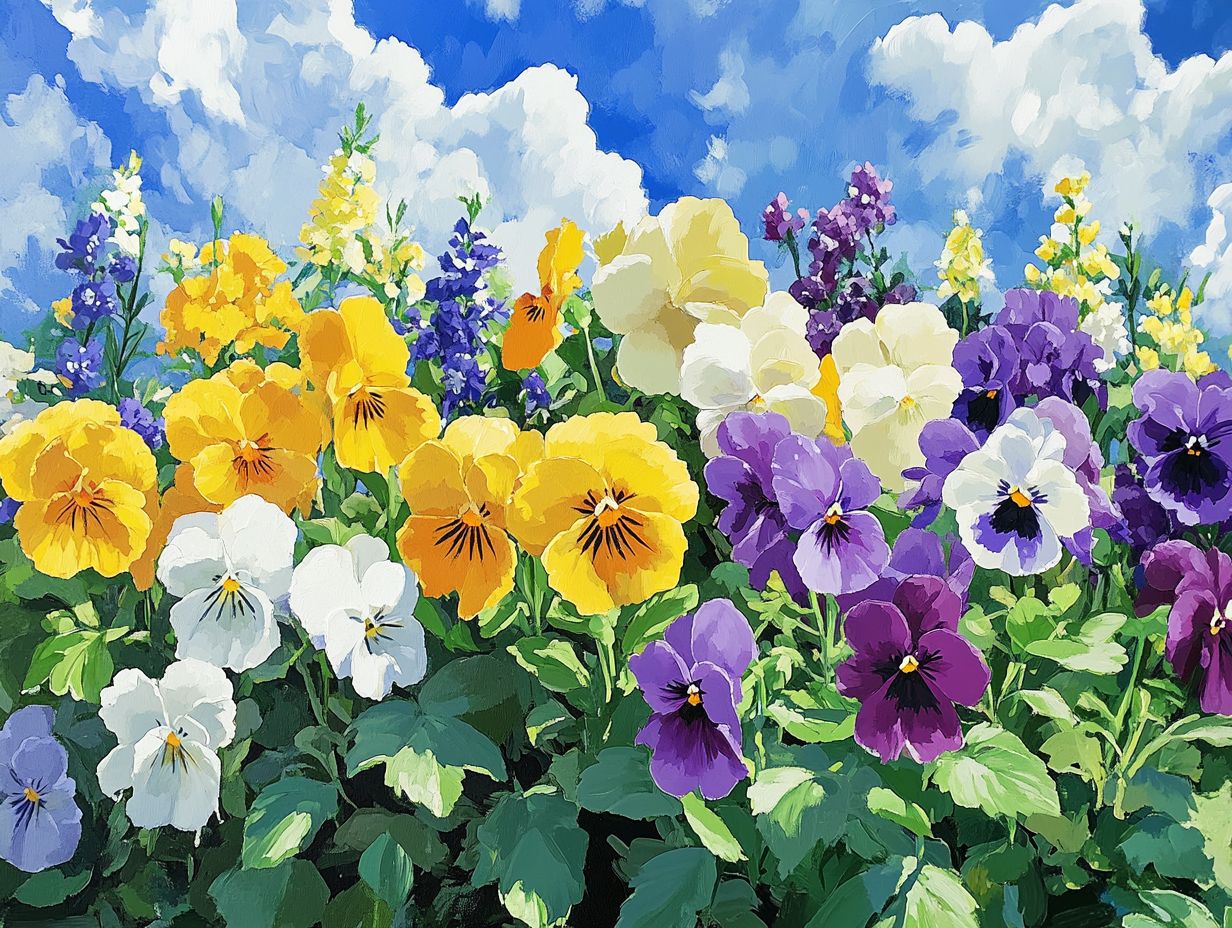
1. Daffodils
Daffodils are among the first flowers to grace your garden with their vibrant hues in early spring. They thrive even when temperatures dip, making them the perfect choice for gardeners who seek seasonal blooms that can withstand challenging climates.
These cheerful flowers come in a delightful variety, from the classic yellow trumpet daffodil to the charming, petite types that flaunt shades of white and orange. With their robust, strap-like leaves and sturdy bulb structure, they demonstrate remarkable resilience against frost and harsh weather conditions.
To ensure they reach their full potential, you ll want to plant daffodils in well-draining soil. Adding a layer of mulch can offer extra frost protection. By placing the bulbs at a depth of six to eight inches, you help shield them from freezing temperatures, allowing these lovely flowers to flourish and return year after year.
2. Tulips
Tulips are cherished for their stunning variety and are ideal for container gardening, allowing you to showcase a burst of colorful blooms in both cozy corners and expansive spaces, even during the cooler months.
With an extensive range of species, tulips present a vibrant palette that spans from bold reds and yellows to soft pinks and purples, each exuding its unique charm. Varieties like Darwin hybrids are renowned for their resilience and impressive blooms, while parrot tulips catch the eye with their fringed petals.
Growing tulips in containers is a breeze; just ensure proper drainage and choose a pot that gives these bulbs ample room to flourish. If you’re in a colder climate, remember to acclimatize your tulips by chilling the bulbs in the refrigerator before planting. This mimics the winter conditions they thrive in.
And don t forget to water them adequately, avoiding waterlogged soil to ensure a vibrant display when spring arrives.
3. Hyacinths
Hyacinths are not merely celebrated for their exquisite blooms; their intoxicating fragrance makes them an ideal choice for your early spring garden, where they flourish even in cooler temperatures.
These perennial treasures present a stunning palette of colors, ranging from vibrant pinks to deep blues, whites, and purples each one adding a unique touch of beauty to your outdoor space. To ensure optimal growth, they thrive in well-drained soil and bask in about six hours of sunlight daily, which promotes the most splendid blooms. Typically blossoming from March to April, their captivating scent can be further amplified with regular watering and careful deadheading of spent flowers.
When given the proper conditions, these charming plants not only illuminate your garden but also envelop it in their heavenly aroma.
4. Pansies
Pansies are resilient cool-season annuals that stand out for their vibrant hues and unique patterns. They are an ideal choice for gardeners seeking hardy flowers that thrive even in cooler temperatures.
These delightful blooms burst with colors that will brighten any garden! You can find shades ranging from deep purples and bright yellows to soft pastels and two-tone flowers. This ensures that your garden is a feast for the eyes.
To truly flourish, pansies prefer well-drained soil enriched with organic matter and require full to partial sunlight.
Don t miss out! Plant them in early spring or fall to ensure vibrant blooms, as they gracefully tolerate frost and chilly weather.
For optimal growth, remember to regularly deadhead your pansies to encourage more flowers. Applying mulch helps retain moisture, and using a balanced fertilizer, which provides essential nutrients for better growth, can extend their blooming period, ensuring a vibrant display throughout the growing season.
5. Violas
Violas are the elegant cousins of pansies smaller, more delicate, yet just as resilient. They re perfect for container gardening and provide valuable frost protection for your early spring blooms.
You ll be delighted by the vibrant array of colors these charming flowers offer. From deep purples and blues to cheerful yellows and whites, this palette allows you to create stunning displays in your pots and planters.
Although both species thrive in similar conditions, violas shine in cooler temperatures, which can influence your selection based on your climate.
When planting in containers, ensure proper drainage and use a high-quality potting mix for the best results. As cool-season plants, violas bring joy and color to your garden when most other blooms are still in hibernation, making them essential for extending your gardening season.
6. Snapdragons
Snapdragons are striking annual plants that capture attention with their unique flower shapes and vibrant hues. They are a superb choice for introducing colorful blooms to your garden, even as temperatures drop.
They boast a stunning array of colors, from soft pastels to bold, fiery tones. This gives you the creative freedom to craft visually captivating arrangements that complement any landscape.
With growth habits that vary from compact, dwarf varieties to towering spires, snapdragons can add depth and interest to your garden beds or borders.
To unlock their potential, embrace proper planting techniques. Ensuring well-draining soil and appropriate spacing can significantly boost their growth and longevity, elevating your outdoor space’s overall design.
7. Sweet Alyssum

Sweet Alyssum is a delightful flower that not only brings beautiful, fragrant blooms to your garden but also excels in container gardening. It thrives even in colder temperatures while enhancing your garden’s aesthetics.
This resilient plant flourishes in well-drained soil and enjoys partial to full sun, making it a versatile choice for various settings.
With its delicate clusters of tiny flowers in shades of white, lavender, and pink, Sweet Alyssum can seamlessly complement other blooms in your floral arrangements. Its sweet scent attracts beneficial pollinators like bees and butterflies, playing a crucial role in supporting local ecosystems.
If you aim to create stunning centerpieces or garden borders, incorporating this perennial will elevate your design while promoting a more diverse garden environment.
8. Primroses
Primroses are among the first flowers to grace your garden in spring. Their vibrant hues create a captivating display that brightens even the coldest corners.
These delightful plants come in various types, including the beloved wild primrose (Primula vulgaris), the charming drumstick primrose (Primula denticulata), and the bold evening primrose (Oenothera biennis).
Each variety boasts unique colors, sizes, and blooming seasons, adding to their allure. To help your primroses flourish, they prefer well-drained, humus-rich soil and a spot that enjoys partial shade.
By clustering different varieties together, you can craft a stunning visual tapestry that lasts throughout spring. Pairing primroses with other spring bloomers like daffodils or tulips brings depth and contrast, transforming your garden design into something truly enchanting.
9. Bleeding Hearts
Bleeding Hearts are enchanting flowers that add an artistic flair to your garden with their heart-shaped blooms. They thrive in cooler temperatures, offering a delightful contrast to more traditional spring flowers.
These attractive flowers do best in partially shaded areas with well-drained soil. They make perfect companions for ferns and hostas, which enjoy similar light conditions.
Keep the soil moist to ensure these beauties thrive! As these blossoms unfurl in shades ranging from soft pink to pristine white, they can beautifully enhance your garden’s overall look.
By strategically placing Bleeding Hearts alongside plants with varying textures and heights, you can create a visually striking display that captures visitors attention.
10. Peonies
Peonies are gems in the gardening world, celebrated for their lush blooms and enchanting fragrance. You’ll find they re a favorite for creating stunning flower arrangements.
These perennial beauties come in various types, including herbaceous, tree, and intersectional peonies (a hybrid of herbaceous and tree varieties). Each type boasts unique characteristics and a spectrum of colors.
For optimal growth, plant them in well-drained soil where they can soak up plenty of sunlight. Don t forget to provide regular watering during their formative stages to set them up for success.
Understanding the role these blooms play in floral design, you ll see how they lend an exquisite touch to bouquets with their voluptuous petals and vibrant hues. Their presence elevates a garden’s look, transforming ordinary spaces into breathtaking retreats brimming with charisma and fragrance.
11. Lilacs
Lilacs are cherished flowers, renowned for their captivating fragrance and stunning clusters that grace your garden in early spring. They infuse a sense of nostalgia and beauty, flourishing even in colder temperatures.
With over 20 species and a remarkable variety of cultivars, these resilient shrubs come in a spectrum of colors, from rich purples to gentle pinks and whites.
Depending on the variety you choose, they can reach heights of anywhere from 4 to 15 feet. They thrive best in well-drained soils and basking in ample sunlight for optimal growth.
To enjoy a bounty of robust blooms, regular pruning is essential to encourage airflow and promote fresh growth. By incorporating lilacs into your garden design, you can create striking focal points or elegant hedges that harmonize beautifully with other spring flowers.
Plus, they attract pollinators, enriching the overall ecosystem of your garden.
12. Hellebores
Hellebores, often referred to as Lenten Roses, are resilient annuals that grace your garden with early spring blooms. Their cool-toned flowers stand strong against the chill, making them an exceptional choice for enhancing seasonal beauty.
With their elegant, nodding blossoms in shades of white, pink, and deep burgundy, these plants elevate the aesthetic of your garden and attract cherished pollinators when few other blooms are around. They thrive in well-drained soil and prefer partial to full shade, making them perfect for tricky spots under trees or in shaded corners of your landscape.
If you’re looking to enrich a woodland garden or cultivate a serene, shaded retreat, integrating hellebores provides both splendor and low maintenance.
You can pair them beautifully with early spring bulbs or combine them with ferns for a lush, layered look that enhances the tranquility of your space.
13. Snowdrops
Snowdrops are some of the first flowers in your garden after winter, often peeking through the snow and symbolizing the arrival of spring. These resilient perennial plants thrive in the cold, reminding you of nature s tenacity.
With their delicate, nodding white flowers and slender green leaves, snowdrops can brighten even the bleakest landscapes. They thrive in well-drained soil and adapt beautifully to various light conditions, from partial shade to full sun.
When planting snowdrops, place them in groups. This allows their enchanting forms to create a captivating display as they multiply over time and ensures proper spacing for airflow. This arrangement highlights their natural beauty, making them a joyful addition to your garden as the seasons transition.
14. Crocuses
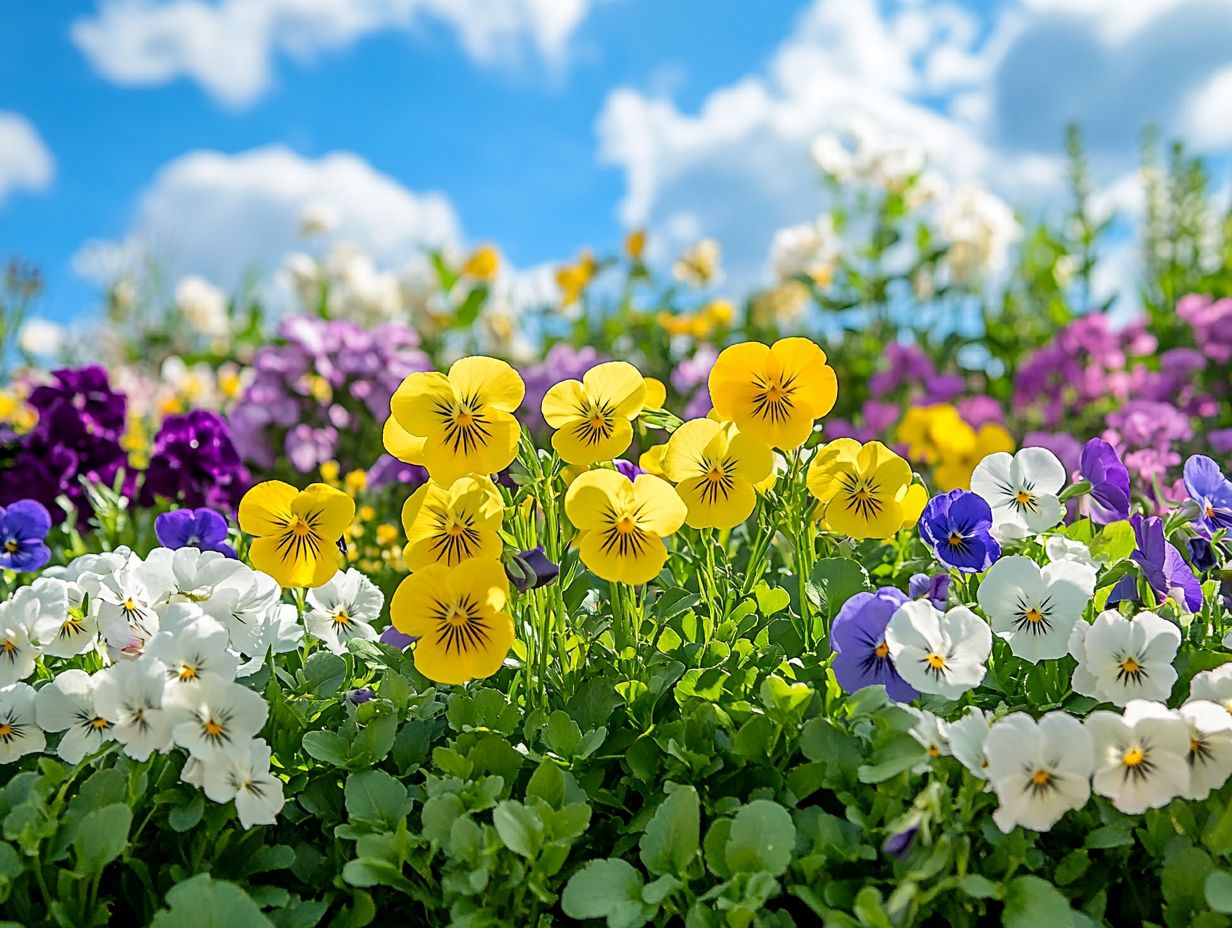
Crocuses bloom in early spring, showcasing a vibrant array of colors that cheerfully herald the season s change, thriving even when temperatures dip.
You ll find these hardy perennials come in various types, such as the striking yellow Crocus chrysanthus, often one of the first to grace your garden, and the bold purple Crocus vernus, known for making a statement. Each variety has its own preferences some thrive in full sun, while others can handle a bit of partial shade.
To ensure they reach their blooming potential, plant corms (bulb-like structures that store energy for growth) in well-drained soil at a depth roughly three times their height.
Adding organic matter to your soil can significantly enhance fertility, paving the way for robust growth and a delightful burst of color that announces spring s arrival.
15. Irises
Irises burst into your garden with captivating shapes and vibrant colors. They make an exceptional choice for infusing bold elements into your garden design, offering seasonal blooms even during the cooler months.
With varieties like bearded, beardless, and dwarf irises, these resilient plants flourish in a range of environments, from sunny flower beds to partially shaded spots. They generally favor well-drained soil and require moderate watering, as they dislike sitting in stagnant water root rot is not a welcome guest in your garden.
Once established, irises demand minimal maintenance. Simple deadheading of spent blooms encourages new ones to thrive. Their vivid hues, spanning from rich, deep purples to cheerful yellows, provide a stunning visual impact, making them favorites for flower arrangements and enhancing the overall beauty of any outdoor space.
Add these stunning flowers to your garden today for a burst of color this spring!
What Makes These Flowers Ideal for Cold Climates?
These flowers are perfect for cold climates, as they are specifically bred or adapted to thrive in lower temperatures. For more options, check out flowers for late blooming in cold climates.
They showcase hardy annuals and a range of gardening methods that enable you to create resilient and vibrant gardens, even under challenging conditions.
Their remarkable ability to withstand frost and adapt to fluctuating temperatures is crucial for their success. This ensures you can enjoy flourishing blooms when the mercury dips.
Employ strategies such as mulching, selecting the right soil, and using planting techniques to support their growth. You will also create a microclimate that enhances resilience.
Choosing the right varieties that naturally fend off pests and diseases allows for robust development throughout harsh winters. By adopting these gardening practices, you’ll be amazed by the stunning displays you can cultivate in even the most frigid areas, enriching your landscape despite the chill in the air.
How Should These Flowers Be Planted and Cared for?
To ensure your beautiful flowers thrive in cold climates, proper planting techniques and care are essential. You’ll want to adjust the plants to their environment and consider incorporating plants that bloom early in cold weather while providing adequate frost protection during the chillier months.
When you’re planting perennials, it’s crucial to amend the soil with organic matter to boost drainage and nutrient availability. On the other hand, flowering annuals might require a slightly different approach, favoring well-draining soil bathed in sunlight.
Watering needs vary; some flowers flourish with consistent moisture, while others prefer a drier touch.
To protect your delicate blooms from unexpected frost, consider using mulch or frost cloths during chilly spells. This way, you ll ensure they stay vibrant and healthy.
By tailoring your techniques to the specific flower types, you can create a thriving garden, even in challenging weather conditions.
What Are Some Other Considerations for Planting Annuals in Cold Climates?
When you’re planting annuals in cold climates, several key factors can ensure their successful growth. You’ll want to select the right varieties, including perennial herbs for cold-climate gardens, and employ effective gardening techniques.
It’s also essential to time your planting to correspond with seasonal blooms. Understanding the details of local weather patterns can significantly impact your success with annuals.
They can be vulnerable to late frosts or unexpected temperature drops. Opting for varieties specially bred for shorter growing seasons can bolster the resilience of your garden.
Consistent maintenance practices like regular watering, fertilization, and pest management are vital for keeping your plants healthy.
Be aware of challenges such as limited sunlight or excessive moisture, which can influence growth. Adapting your strategies to address these factors will help you nurture your annuals throughout their lifecycle.
Doing so ensures a vibrant and thriving garden.
How Can These Flowers Add Color and Beauty to a Garden?
These flowers can dramatically elevate the color and beauty of your garden. They play a key role in your garden design with their vibrant hues and textures.
When you intersperse them thoughtfully among other plants, they enhance the overall aesthetic and foster a sense of harmony within the space.
Selecting varieties with contrasting shapes and heights allows your garden to gain depth and interest that naturally draws the eye.
Blending these blossoms with foliage that accentuates their unique characteristics will ensure a captivating display throughout the seasons.
As a discerning gardener, you can harness their versatility to craft stunning focal points or soften borders. Transform any outdoor area into a serene retreat that invites admiration and introspection.
Start your cold-climate garden today and watch it thrive!
What Are Some Tips for Extending the Blooming Season of These Flowers?
Want to enjoy beautiful blooms all season long? You can extend the blooming season of your flowers with a few simple gardening tips.
You can achieve this through proper care techniques and strategic planting. Consider planting at different times for a continuous display of blooms.
Using plants that grow well together enhances both the beauty and health of your garden. Imagine a garden bursting with colors!
Incorporating various flower types, each with unique blooming periods, can keep your garden lively throughout the season. Careful planning maximizes aesthetic impact and fosters a healthy garden.
Frequently Asked Questions
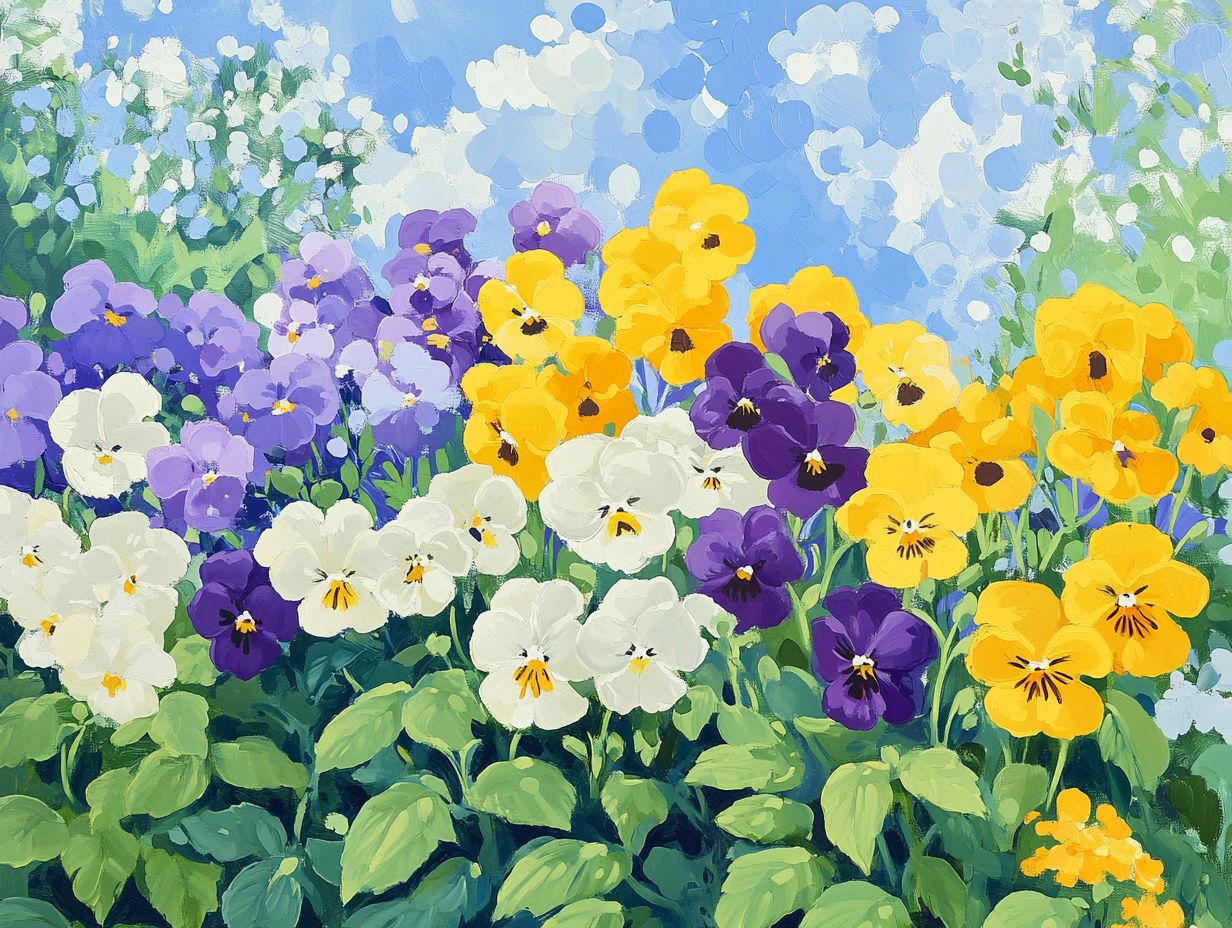
What are the best annual flowers for spring in cold climates?
Some of the best annuals for cold-climate gardening in spring include pansies, snapdragons, dianthus, violas, and petunias.
Can I plant annual flowers in cold climates?
Yes, you can plant annual flowers in cold climates. Just choose the best plants for cold-climate wildflower gardens that can withstand cold temperatures.
When is the best time to plant annual flowers for spring in cold climates?
The best time to plant annual flowers for spring in cold climates is usually in late winter or early spring, just before the last frost date. To ensure you’re choosing the right varieties, check out what are the best cold-weather annuals.
How can I protect annual flowers in cold climates?
To protect annual flowers in cold climates, consider using row covers, mulch, or bringing them indoors during extreme cold. You might also explore flowers that withstand cold weather for more resilient options.
What are some tips for caring for annual flowers in cold climates?
Care for annual flowers by watering them regularly, deadheading spent blooms, and fertilizing according to package instructions.
Are there any annual flowers that can withstand freezing temperatures?
Yes, some annual flowers can withstand freezing temperatures, such as pansies, violas, and snapdragons. For those interested in enhancing their gardens, exploring specific plants for pollinators in cold climates can also yield hardy varieties that survive light frosts and even snow.

